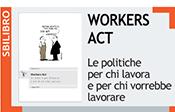Ultimi link in questa sezione
Come trovare 900 miliardi di dollari a Wall Street
Executive Summary
• Don’t finance the bailout with more debt
• Make Wall Street speculators pay now
• Raise $900 billion in new revenue
• Stimulate Main Street and the real economy
As Congress debates the particulars of the inevitable bailout, one key question has gone largely unexplored: Who will pay for this mess?
Lawmakers in Congress appear to have assumed that the federal government will simply borrow more money to foot the bill for the bailout. The national debt ceiling will rise to a whopping $11.3 trillion, up from $8 trillion a year ago.
But this rush to borrowing merely shifts the bailout burden onto the backs of future taxpayers. Congress needs to change course — and develop a “pay as we go” plan that makes Wall Street pay. The lion’s share of bailout funding should come from the high-finance gamblers and the wealthy CEOs who have so profited from our casino economy.
Funding the Bailout: Basic Principles
• Wall Street and speculators should pay now for the mess they created.
• Instead of borrowing from the super-wealthy beneficiaries of the casino economy, we should tax them.
• Any bailout should stimulate the real economy with investments in Main Street, not just Wall Street.
Broadening the Bailout Dollars
The debate over the bailout has so far concentrated on the $700 billion purchase of “troubled assets” proposed by Treasury Secretary Henry Paulson. A real “bailout” would also target the troubled households of working American families. A $200 billion “Main Street Stimulus Package” could bolster the real economy and those left vulnerable by the subprime mortgage meltdown.
This package should include:
• A $130 billion annual investment in renewable energy to stimulate good jobs anchored in local economies and reduce our dependency on oil.
• A $50 billion outlay to help keep people in foreclosed homes through refinancing and creating new homeownership and housing opportunities. These funds could also help those locked out of the American Dream to purchase homes through non-speculative mortgage programs.
• A $20 billion aid package to states to address the squeeze on state and local government services that declining tax revenues are now forcing.
A Responsible Plan to Pay For Recovery: $900 billion in New Revenue
Below is our ten-point program to pay for this broader bailout. This plan would generate $900 billion a year until the costs of the bailout and stimulus program are paid for.
1. A Securities Transaction Tax: $100 Billion.
A fair plan to pay for the bailout should include a modest financial transactions tax on the buying and selling of stock and other financial products. A penny on every $4 invested would generate $100 billion a year. Other European countries already tax stock transactions, and these transaction taxes effectively discourage speculation.
2. A Wealth Tax Surcharge on Households with $10 million: $300 billion
Congress should institute a modest wealth tax surcharge on households with net worth over $10 million. These households currently own and control over 20 percent of the nation’s private wealth. They have realized huge gains from the manipulation of capital markets and the asset bubbles that created the current crisis. A modest surcharge — no more than 3 percent — could generate over $300 billion.
3. A Corporate Minimum Income Tax: $60 Billion
In August, the Government Accountability Office reported that two-thirds of U.S. corporations paid no income taxes between 1998 and 2005. These corporations paid nothing toward our shared expenses of defense, environmental protection, public health, and education. Ordinary taxpayers should not be left holding this bag. A minimum corporate income tax should contribute toward the bailout.
4. A ‘Disgorgement’ Recovery from Profligate CEOs: $40 Billion
Until several weeks ago, top CEOs and managers were collecting massive salaries and fees while they told the rest of us that “everything is fine.” These CEOs gorged themselves and have taken the money and run. The four biggest investment banks on Wall Street shelled out $30 billion in bonuses last year. One of them, Lehman Brothers, has just gone under. Another, Bear Stearns, was bailed out earlier this year. To help pay for recovery, the new Treasury authority should seek the payback of executive compensation inappropriately extracted in the years before the Wall Street meltdown.
5. An Income Tax Surcharge on Incomes over $5 Million: $105 Billion
A portion of the bailout cost should be financed with an emergency income tax surcharge on incomes over $5 million. Wealthy investors have been the big winners in the unregulated bubble economy. They have watched their incomes skyrocket over the last 25 years. Meanwhile, President George W. Bush has cut their taxes for seven years. Instituting a 50 percent tax rate on income over $5 million and a 70 percent rate on income over $10 million would generate $105 billion a year until the bailout is paid for.
6. An End to Overseas Corporate Tax Havens: $100 Billion
Congress should close down corporate tax havens that allow corporations to game the system and cut their taxes, sometimes to zero. This step would generate $100 billion from profitable companies that have paid no taxes over the last decade.
7. The Elimination of Subsidies for Excessive CEO Pay: $20 Billion
As taxpayers, we subsidize excessive CEO pay, through a host of tax loopholes, to the tune of $20 billion a year. Congress should close these loopholes, including the accounting gimmicks that permit companies to report one set of earnings to shareholders and another lower number to Uncle Sam.
8. The Elimination of the Tax Preference for Capital Gains: $95 Billion
The mega windfalls that Wall Street executives have pocketed over recent years will be generating additional income, in the form of dividends and capital games, for years to come. Under current tax law, dividend and capital gains income faces a mere 15 percent tax rate while income from actual work can be taxed at rates that go up to 35 percent. Taxing wealth and work at the same rates would generate $95 billion a year in revenue.
9. A Progressive Inheritance Tax: $60 Billion
In the near future, the moguls of the past quarter-century will be passing off the scene and leaving behind dynastic-size fortunes. A portion of this wealth should be taxed. A progressive estate tax on estates over $2 million — $4 million for a couple — could generate $60 billion a year in the short term and much more in outlying decades.
10. The Elimination of the Mansion Subsidy: $20 Billion
Wealthy taxpayers can currently deduct their mansion mortgage interest off their taxes. The richest 2 percent of U.S. households do not need to be subsidized by American taxpayers. Capping the home mortgage interest deduction for households with incomes over $200,000 per year would generate $20 billion a year.










